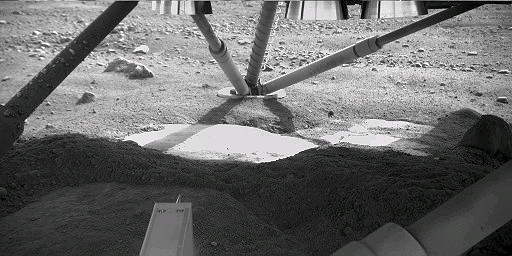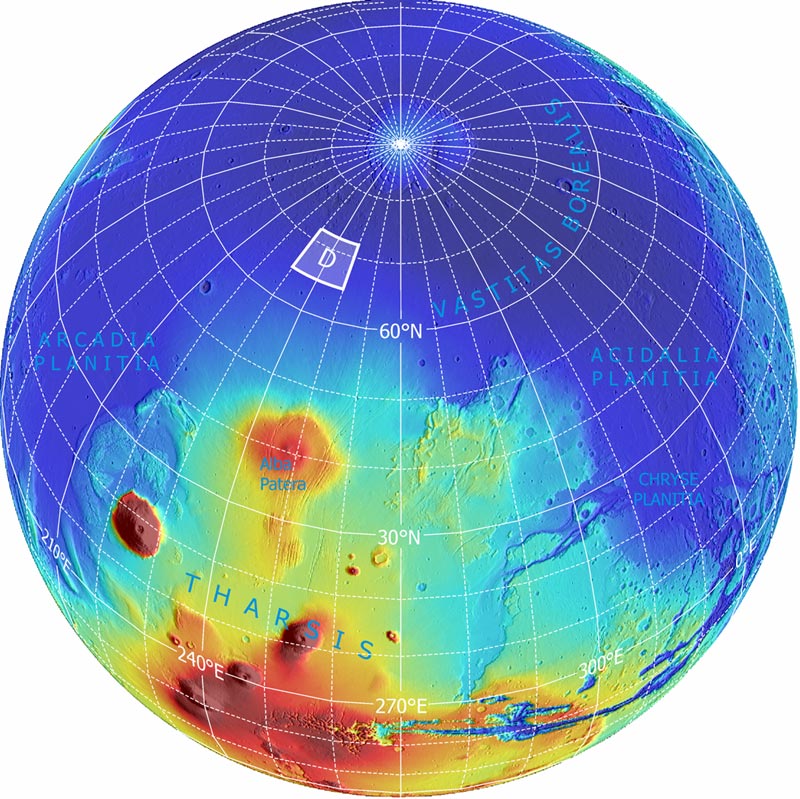 Ice on Mars! Umm… duh…
Ice on Mars! Umm… duh…
So, Phoenix found some ice on Mars. Yay! Here’s JPL’s picture:
Credit: NASA/JPL-Caltech//University of Arizona/Max Planck Institute
So, this is great, but I’m not gasping with shock, or even amazed. This was expected. Also, this is not the first time we’ve found water or ice on Mars. Let me recap an old AstroInfo for you that explains exactly how many times we’ve “discovered” water on Mars.
My post from 2006. Contains a complete table of the multiplicitous discoveries of water on Mars.
Added 6/2/2008: And now we’re sitting on ice. This is wonderful, this is exactly where Phoenix wanted to be. They want to study ice, because ice is water, and water is necessary for life as we know it. By analyzing the ice, they’ll be able to work on both of their primary objectives: “Study the History of Water in All its Phases“, and “Search for Evidence of Habitable Zone and Asses the Biological Potential of the Ice-Soil Boundary”
Good for them, but remember, it’s not the first time we’ve found water on Mars.
Some Sources:
Emily Lakdawalla’s Interpretation: http://www.planetary.org/blog/article/00001485/
The Press Release: http://www.jpl.nasa.gov/news/news.cfm?release=release=2008-090b
 At ASP
At ASP
Well, I’m at ASP (the Astronomical Society of the Pacific joint meeting with the American Astronomical Society) in St. Louis, and I finally decided that AstroInfo deserved a blog, instead of just a posting on the staff bulletin board. So here we go. And Phil Plait himself convinced me to join Facebook. So I’m there too.
I posted an AstroInfo from earlier this month to get you started. It hasn’t hit the web yet, but all you AstroInfo readers have seen it already.
Enjoy!
 Updating …
Updating …
I’m in the process of transferring old AstroInfos to this new home. For a while they’ll be badly-formatted, badly-coded, and will completely lack pictures. Forgive me. I am not perfect, and can’t do everything at once, so I’m changing them over a bit at a time: text first, then formatting, then pictures.
Bear with me.
 We Caught One! SWIFT Sees a Supernova!
We Caught One! SWIFT Sees a Supernova!
Podcast of We Caught One! SWIFT Sees a Supernova
Caught in the Act …
Alicia Soderberg and her colleagues (I’ve since read that she was on a plane, and her friend actually noticed this) got very lucky. She had NASA’s Swift X-Ray Telescope pointed at a galaxy (NGC 2770 in the Northern constellation Lynx) when a supernova exploded right where she was looking.

Credit: NASA
Caption: SWIFT X-ray image (left) of Supernova 2008D, Visible image (right) of NGC 2770
Although there are historically recorded observations of supernovae (1987A, Tycho’s Star, SN1054), never before has a telescope recorded the actual beginning of the outburst. Usually we see the remnant of the supernova, or catch just the middle or the end of the bright explosion.
More Detail, More Accurate:
What Alicia saw is actually sort of the pre-signal for the supernova. We’ve seen the other stages of the supernova a few times before.
Scientists have been predicting that the first event as a star collapses into a supernova should be a humongously bright flash of X-Rays. Unfortunately, by the time we detect a supernova in progress, this flash has already finished. No matter how fast our telescopes turn, we can’t catch the X-Ray flash – though we can get most of the rest of the supernova, including most of the visible-light flash, the brightening of the area, and the dimming away.
Alicia and her team observed the bright flash lasting for about 5 minutes at 9:30 in the morning on January 9th of this year.
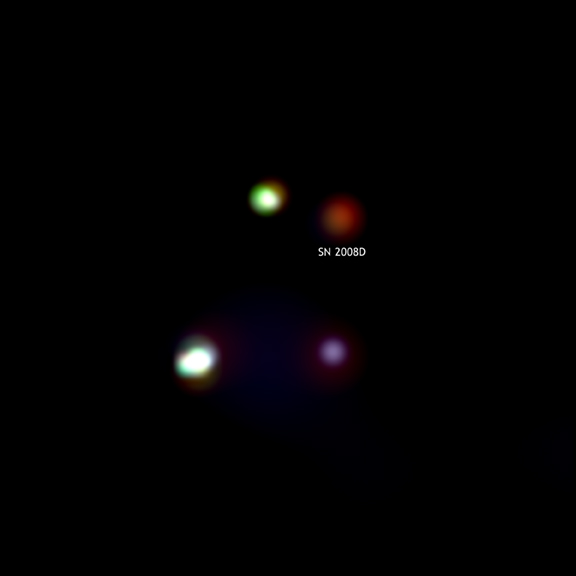
Credit: NASA/CXC/Wisconsin/ D.Pooley et al.
Caption: Chandra X-ray Observatory image of the region around SN 2008D, obtained about 10 days after the supernova explosion. The faint red source in the upper right is SN 2008D. The other 3 X-ray sources are unrelated to this supernova.
Did you want statistics?
Constellation: Lynx
Observation Dates: 01/19/2008
Observation Time: 5 hours
Instrument: ACIS
References: Soderberg et al. 2008, Nature, in press.
Distance Estimate: 90 million light years.
Want More?
The Supernova: http://chandra.harvard.edu/photo/2008/sn2008d/
SWIFT: http://www.nasa.gov/mission_pages/swift/main/index.html
 A Series of Questions (II)
A Series of Questions (II)
For this week’s AstroInfo I’m going to answer a set of questions posed by youth who are currently training to offer space-related interactive activities out among the Pacific Science Center’s exhibits. In several places I express my personal opinion – which you should note is NOT the same as fact.
When can the general population go into space without paying a lot of $?
Who knows, maybe 10 years? Maybe two years, maybe 50? There is a competition called the “X Prize” that’s trying to jumpstart space travel (and other sciences). Until a couple years ago, no new spaceships for carrying people had been invented since the Shuttle. The Ansari X-Prize (http://www.xprize.org/x-prizes/ansari-x-prize) offered $10 million dollars to anyone who could “launch a spacecraft capable of carrying three people to 100 kilometers above the earth’s surface, twice within two weeks.” Burt Rutan and company completed the task on October 4, 2004 – after spending more than $100 million creating SpaceShipOne (go to the Museum of Flight to see a mock-up of it). This should push the space-travel industry along a little faster.
How plausible is human colonization of Mars/Moon in the next 50 years?
My opinion: It’s not. I say that because you used the word “colonization” which I think will take a long time. Right now there’s a plan to send humans back to the Moon and eventually to Mars, but just to visit.
The program is called the Constellation Program and it has three components:
- Orion Crew Vehicle – like the current shuttle
- Ares Launch Vehicles – rocket to carry the Orion
- Altair Lunar Lander – landing people on the Moon
How do they come up with the ideas for finding stars or researching about stars?
What usually happens is that someone notices something strange about a star or something else, and they decide to find out what’s happening. A simple example is a variable star. Someone studying a variable star would notice that on different nights it appeared brighter or dimmer. Then they would want to find out why – is there something traveling in front of the star? Is the star flashing or pulsing? Is the star spinning, and is one part brighter than another? Any of these might affect brightness.
Is there intelligent life outside Earth?
Not that we’ve detected. My opinion: yes.
Does dark matter exist?
Most scientists believe so. Though the evidence is pretty overwhelming, I’m not quite ready to believe it. Redacted as of 6/4/08.
What elements are found in the gases on Uranus?
Edited as of 6/6/08: The atmosphere of Uranus has Hydrogen (mostly), Helium (a little), Methane (a trace), Water (a trace), Ammonia (a trace). The methane, water, and ammonia are all aerosol ices – suspended crystals of ice (not ice cubes or blocks of ice). A later AstroInfo will explain Uranus in more detail. I was embarrassed to realize at the Spring 2008 meeting of the American Astronomical Society that what I thought I knew was significantly wrong.
 Phoenix Landing
Phoenix Landing
What’s the Deal with Phoenix?
Phoenix is going to Mars’s North Pole. Although it does NOT have rover, it has a 7.7 foot long arm.
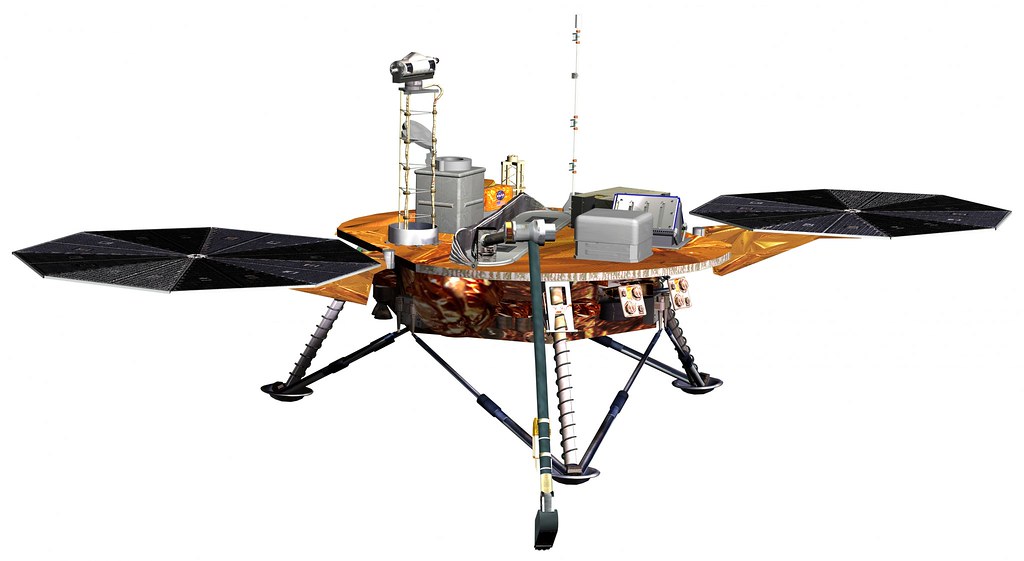
Credit: JPL/NASA/University of Arizona
Caption: Phoenix Lander
What is Phoenix Doing?
Basically? Looking for place life could have been, or could be in the future. (N.B. This is not the same as looking for life).
WATER: Objective 1: Study the History of Water in All its Phases
We know there’s a little water vapor in Mars’s atmosphere, and a bit of water ice mixed in with the carbon dioxide ice at the poles. There are also a few pieces of evidence that there is liquid water in various places. Phoenix will be studying Mars’s water, because Mars is important for three basic reasons.
It shapes land and geology.
Life, as we know it, needs liquid water.
People need water – and can make air (O2) out of water. If we know of or find water there it will simplify human exploration of Mars.
LIFE: Objective 2: Search for Evidence of Habitable Zone and Asses the Biological Potential of the Ice-Soil Boundary.
People are alive. People like having relationships. People connect with living things (other people, cats, fish … bacteria …). This means we are deeply interested in finding life, and that’s a driving force behind all exploration and education about exploration. Objective 2 is a very fancy and specific way of investigating if life could have been on Mars, and where.
What’s Happening on May 25?
EDL. Entry, Descent, and Landing. So, our success rate with arriving safely at Mars is currently not the best. In fact, for US launches, we have about a 70% success rate (Spirit and Opportunity helped boost us up from 50%).
ENTRY:
Just like every entry into any atmosphere (Apollo 11 on Earth, Huygens on Titan, Stardust on Earth, all three rovers on Mars), Phoenix will be protected by a heat shield as it uses friction braking against the atmosphere to slow it to a semi-reasonable speed.
DESCENT:
Once again – just like other atmospheric descents – once Phoenix has slowed to Mach 1.7 a parachute will open to slow the lander even more. So far, so good. We know how to do this.
LANDING:
Here’s where it differs. This will be a powered landing. When the lander disconnects from the parachute instead of inflating airbags it will turn on rockets: landing thrusters. Hopefully this will finish off the descent in a controlled manner. NASA believes this will work – or they wouldn’t have planned it this way. Personally, I see a lot more ways for things to go wrong.
Credit: JPL/NASA/University of Arizona
Caption: Phoenix Landing Site
So, on May 25 turn your browser to http://www.nasa.gov/multimedia/nasatv/ and watch those seven minutes of EDL. Cross your fingers, and check out those first images.
What Instruments Does Phoenix Have?
In short, there are many instruments onboard. The coolest part though? There’s a wet chemistry lab (chemicals, water, experiments to do on samples of Martian ice and soil), and eight tiny ovens to heat and melt similar samples. How exciting!
Don’t Miss These Videos!
Phoenix: Blinded With Science: http://www.nasa.gov/mission_pages/phoenix/multimedia/video_archive_1.html
Seven Minutes of Terror: http://www.youtube.com/watch?v=5TaP8YMM524
Want More?
NASA’s Phoenix Website –http://www.nasa.gov/mission_pages/phoenix/main/index.html
University of Arizona’s Phoenix Website – http://phoenix.lpl.arizona.edu/
Failed Missions To Mars – http://www.universetoday.com/2008/03/22/the-mars-curse-why-have-so-many-missions-failed/
 Asteroid 2007 TU24 NOT Going to Hit the Earth
Asteroid 2007 TU24 NOT Going to Hit the Earth
You may have seen the YouTube video. You may be reading a doomsayer’s blog. Maybe you watched Armageddon a little too recently. However you heard it, it’s not going to happen.
There’s an interesting claim being circulated that an asteroid will hit the Earth tonight. Not only is it not true, the asteroid is going to be so far away (half again as far as the Moon) you won’t even be able to see it (it will be magnitude 10.4)! And, if you’re reading this, Near-Earth Asteroid 2007 TU24 (the suspect rock) will have already passed us by, a near disaster averted by orbital mechanics once again.
Instead, why don’t you tune in to NASA’s press conference about the MESSENGER Mission to Mercury, or take a look at some of the red-hot, brand new photos from this mysterious hot world? Trust me, the new discoveries being made on Mercury are going to be way more awesome than an asteroid you can’t even see. That’s why there’s no photo with this AstroInfo. I don’t want to mislead those of you skimming this article. So, for today, use your imagination for the asteroid, and go to NASA’s website for some pictures of Mercury.
If you want to know more about the asteroid, check out Phil Plait’s commentary from Bad Astronomy.com: or NASA’s press release. You’re smart. Listen to the experts.
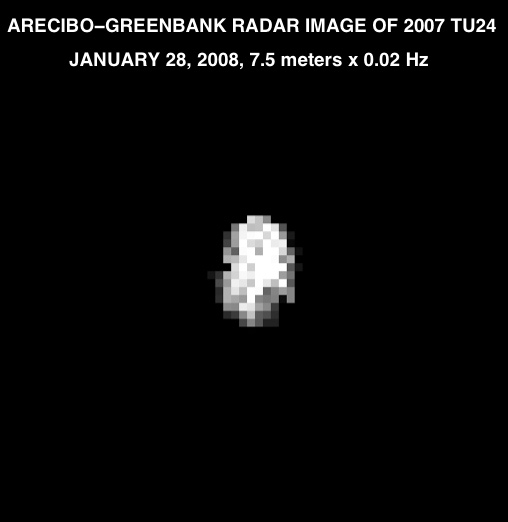
Credit: The Arecibo Observatory in Puerto Rico and the Greenbank Telescope in West Virginia
Caption: The best picture we were able to get of TU24 as it whoosed by
Want More?
Phil Plait’s Commentary: http://www.badastronomy.com/bablog/2008/01/21/repeat-after-me-asteroid-2007-tu24-is-no-danger-to-earth/
NASA’s press release: http://neo.jpl.nasa.gov/news/news157.html
NASA’s MESSENGER Website: http://messenger.jhuapl.edu/index.php
The inaccurate YouTube Video: http://www.youtube.com/watch?v=p2hKPY1jJwM&feature=related
 Diffraction Spikes, or Why Stars Have Points
Diffraction Spikes, or Why Stars Have Points
Stars with Points
Tis the season to draw stars – many different kinds of stars. The classic star drawn by elementary-schoolers is a 5-pointed star created in a single stroke, leaving a pentagon in the center. Other hand-drawn classics include: a “Star of David”-style star: two overlapping triangles; a simple starburst of three or more overlapping lines; and a “Christmas” star: four overlapping lines with a longer tail.
A real star is a giant sphere of burning gas. Sometimes we draw stars as single dots, but we almost always draw our stars with points. Why? I don’t know. I do know that photographs of stars through telescopes also exhibit “points.”
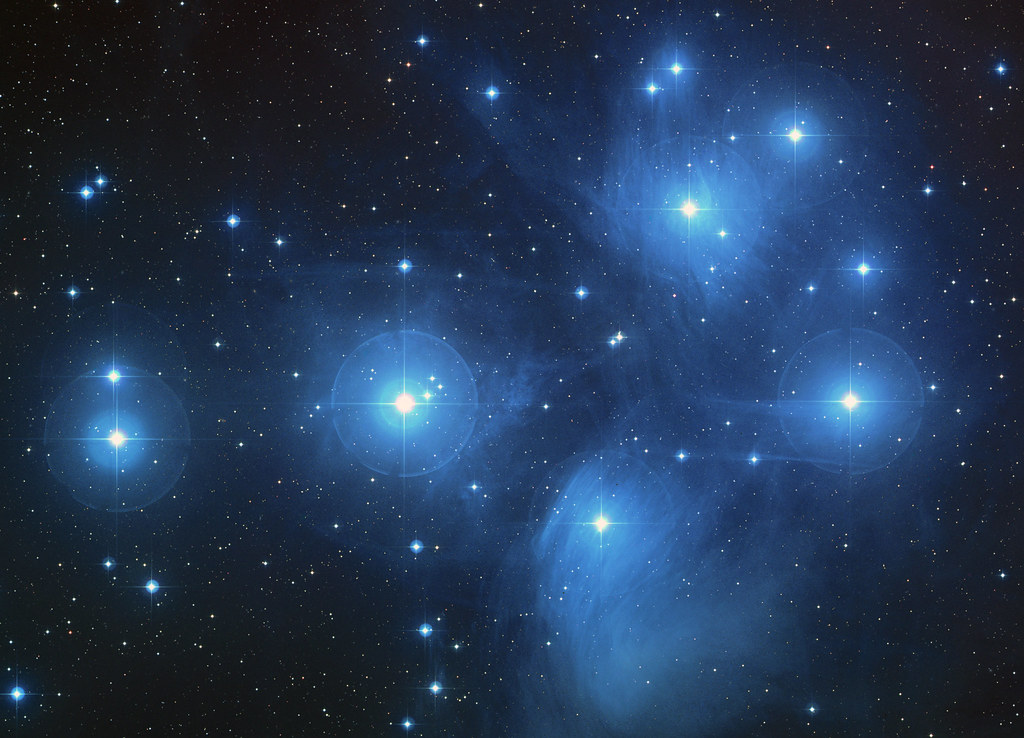
Credit: Robert Gendler
Caption: The Pleiades with Diffraction Spikes
Telescopic Spikes:
The spikes on a star in a telescope’s photograph are an artifact from the telescope itself. (An artifact is something in a photograph that looks real, but isn’t actually there).
Most large telescopes have lenses or mirrors inside that are between the main opening of the telescope and the main mirror or lens. These smaller bits have to be held up in the middle of the telescope tube somehow. The easiest way? Struts. Support rods. These small struts then deflect the light from the stars, and cause spikes to show up on the image.
Diffraction spikes show up on point-sources of light (like stars) because the light is coming from one location, not many. You can use this technique to identify stars in a photograph, and differentiate them from nebulae and galaxies. Mostly.
Diffraction:
A subject for another AstroInfo. In short though, light acts like a wave pattern, so when it encounters an edge or corner, it bends. When light goes around a strut or rod, it splits into two wave-like patterns, which bend around the two edges (left and right) and recombine on the other side of the barrier. This results in prettiness. Diffraction gratings (special little pieces of iridescent, clear plastic) are a fun way to observe lights of all kinds. You can buy them in the store this time of year as “holiday glasses” or “Christmas light viewing glasses.” They’ll make every point of light you see have a little snowflake or “Ho Ho Ho” around it. (They’re doing even cooler optical tricks.)
Want More?
Do this experiment at home! – http://www.exploratorium.edu/snacks/diffraction.html
Astronomy Picture of the Day – http://antwrp.gsfc.nasa.gov/apod/ap010415.html
A Short Brittanica Article – http://www.britannica.com/ebc/article-9362735
Wikipedia (decent article, last I checked) – http://en.wikipedia.org/wiki/Diffraction
 Comet Holmes (a.k.a. 17P)
Comet Holmes (a.k.a. 17P)
Don’t miss Comet Holmes – visible tonight, and possibly all of November. It’s starting to dim down though, so go outside and check it out as soon as a clear night comes along.
This is a photo my husband and I took last night (November 5, 2007) through our little 4-5 inch Celestron NexStar telescope. It’s not very bright, but you can see the off-center bright spot in the middle.
Finding the Comet:
To find it, you’ll look for the constellation Perseus. At about 8pm tonight, look east. You’ll see a fairly bright star above the horizon. That’s Capella. Look above it. Before you get to the next brightish star there will be a smudge. You’ll think it’s a star. It looks like someone just tried to erase a star with a bad eraser that left a mark behind. That’s the comet.
You can see it from the city, with streetlights shining in your eyes – but the darker it is around you, the better it will be. If you have binoculars or a telescope, use them to see more detail.
What the Scientists Think:
A fascinating thing happened to 17P (the name assigned to the comet by scientists): two weeks ago it was invisible to the casual observer. You needed a pretty good telescope to find it. Then, on October 24th it suddenly became a lot brighter. Now, all eyes are on it, without any ‘scopes or binoc’s. Turns out, this is an exploding comet!
You can see in the images (and in binoculars) an expanding cloud around the center of the comet. This is a dust cloud that the comet spit off when it exploded. According to Sky and Telescope, this isn’t the first time this comet has exploded: when Mr. Holmes discovered this comet (115 years ago) it was exploding. Then it exploded again! This is the third time in recorded history that this comet has become so spectacular.
I don’t think it’s so strange for a comet to explode – they’re constantly off-gassing (small explosions of released gas) because of they’re made of ices that heat up and sublime as they approach the Sun. This comet just seems more volatile than most. Keep an eye out though: science may say something different about this comet when we learn more.
Take this chance to look at one of the five most exciting comets of the decade! Go out tonight! Keep looking up.
Want More?
Where to find it: http://www.skyandtelescope.com/observing/home/10862521.html
The best photos: http://www.cometography.com/pcomets/017p.html
Make a comet at home: http://www.noao.edu/education/crecipe.html
(QFC is a local place that sells dry ice)
 Sputnik’s 50th
Sputnik’s 50th
There is a strong argument that Sputnik is the reason the Pacific Science Center exists today.
Sputnik, the little, silver, antennaed ball with its classic “peep peep” radio signal, was launched on October 4, 1957. It marked the end of the first round of the Space Race, and lit a fire in the imaginations of people around the world, especially those in the United States. The unthinkable had happened: first, there was a man-made object circling around the Earth, and second, the Soviet Union had accomplished it first.
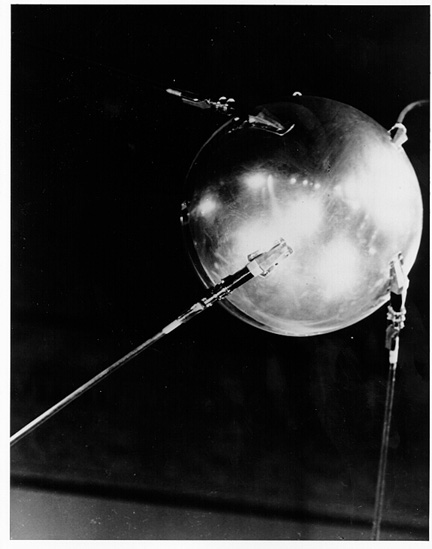
Credit: NASA
Caption: Sputnik
People everywhere heard the “peep peep” signal on their home radios (Sputnik broadcast at 20.007 MHz: a shortwave radio signal, that we now listen to on AM stations), and at night saw the star-like dot traveling across the sky. Suddenly outer space wasn’t just a dream in fantasy novels by Jules Verne. Within 15 years animals and people began spending time in space, and humans had touched the Moon.
Now that space was no longer a dream, we needed people to figure out how to get there and back again, safely. We needed rocket scientists. We needed materials engineers. We needed astronauts. We needed physicists, chemists, biologists, doctors, and veterinarians. In short, we needed all sorts of scientists to work on the space program – and everyone wanted to be part of it. Children around the world began to dream of being astronauts.
Building on this fervor, the United States Science Pavilion was constructed for “Century 21,” the 1962 World’s Fair. The pavilion showcased America’s scientific achievements, and inventions that pushed us further along in the Space Race with the Soviet Union. The public’s enhanced interest in science due to the Space Race made the pavilion a popular destination for visitors of all ages.
The day after the World’s Fair closed, the Science Pavilion was renamed, and opened to the public as Pacific Science Center. Though the space craze has faded over the years, Pacific Science Center continues to inspire a lifelong interest in science, mathematics and technology by engaging diverse communities through interactive and innovative exhibits and programs.
Want More?
http://history.nasa.gov/sputnik/ – You can hear the original “peep peep” at NASA’s site.
http://www.skyandtelescope.com/news/home/10206211.html – Sky and Telescope’s top story this month is all about Sputnik.

